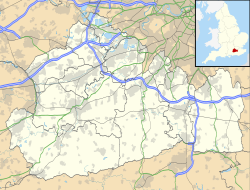Salvation Army Hall, Godalming
| Salvation Army Hall | |||||||||||||||||||||||||||||||||||||
|---|---|---|---|---|---|---|---|---|---|---|---|---|---|---|---|---|---|---|---|---|---|---|---|---|---|---|---|---|---|---|---|---|---|---|---|---|---|

The former Salvation Army hall in 2015 after conversion into an office
|
|||||||||||||||||||||||||||||||||||||
|
|||||||||||||||||||||||||||||||||||||
29 September 2012
The former Salvation Army Hall in Godalming, Surrey, England, now an office building known as Aurum House, has been used by three religious groups since its construction c. 1830. The ancient town in the English county of Surrey has a long and diverse history of Protestant Nonconformity, and three Nonconformst denominations are represented: at first it served Congregationalists, but when they built a larger chapel in the town it passed to the Methodist Church. In the 20th century it was occupied by The Salvation Army, but it closed in 2012 and was redeveloped for commercial use. The building has been listed at Grade II for its architectural and historical importance.
Godalming is an ancient town with mainly industrial origins, which were conducive to the spread of Nonconformism. Attendances at conventicles exceeded those at the parish church, St Peter and St Paul's, where the Anglo-Catholic views of the priest in the late 17th century did not represent the majority of inhabitants, who were "overwhelmingly Puritan in belief and practice". Numerous informal Nonconformist groups developed in and around Godalming at this time.
One such group was Congregationalists, which had a sufficient following by 1730 they acquired land on Hart's Lane and built a chapel. The congregation "may be considered ... the lineal representative of the conventicle of the reign of Charles II", which had 700–800 worshippers every Sunday at a time when Godalming's population was 3,000. Hart's Lane, now known as Mint Street, is one of several small streets immediately west of the town centre, characterised by small, unrestored 16th- and 17th-century cottages. (Proposals to demolish these streets and all the buildings in favour of a ring road were made in 1969 but were not acted upon.) The land for the chapel was bought for £20 in January 1729, and construction soon followed. Ebenezer Chapel, as it was called, was put under the charge of the Surrey Congregational Mission in 1799. In the early 19th century it was served by a succession of student pastors from Homerton College, Cambridge. One, John Nelson Goulty, later came to prominence during his 37-year incumbency at Union Chapel, Brighton. During his much shorter stay in Godalming, "the cause considerably revived" and he also preached in the nearby villages of Elstead and Hascombe.
...
Wikipedia

